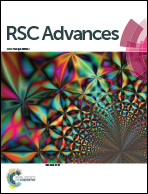Highly transparent and conducting C:ZnO thin film for field emission displays
Abstract
Incorporation of carbon into a zinc oxide (ZnO) thin film has led to a potential new application as a transparent and conductive oxide thin film. Here, we fabricated carbon doped zinc oxide (C:ZnO) films by RF sputtering at a low temperature, aiming to produce a transparent and conductive screen for transparent field emission displays. The incorporation of highly inert carbon atoms into ZnO thin films can tune the intrinsic defect sites. A co-sputtering technique was used for carbon doping into ZnO, where the dopant amount was controlled by varying the number, size and position of the graphite plates used as the carbon source. A sheet resistance of 37 Ω □−1 and a transmittance of 84% at a wavelength of 550 nm were achieved for the C:ZnO thin film with a nominal carbon concentration of 2.7%. The bonding of carbon with ZnO was analyzed using de-convolution of XPS peak C1s. We also demonstrated the light emission properties of the C:ZnO thin films by fabricating a field emission device. A high current density of 1 mA cm−2 was obtained with a lower applied electric field of 5 V μm−1. Our findings showed that the C:ZnO thin films can be a promising transparent and conducting phosphor screen for a field emission display.


 Please wait while we load your content...
Please wait while we load your content...